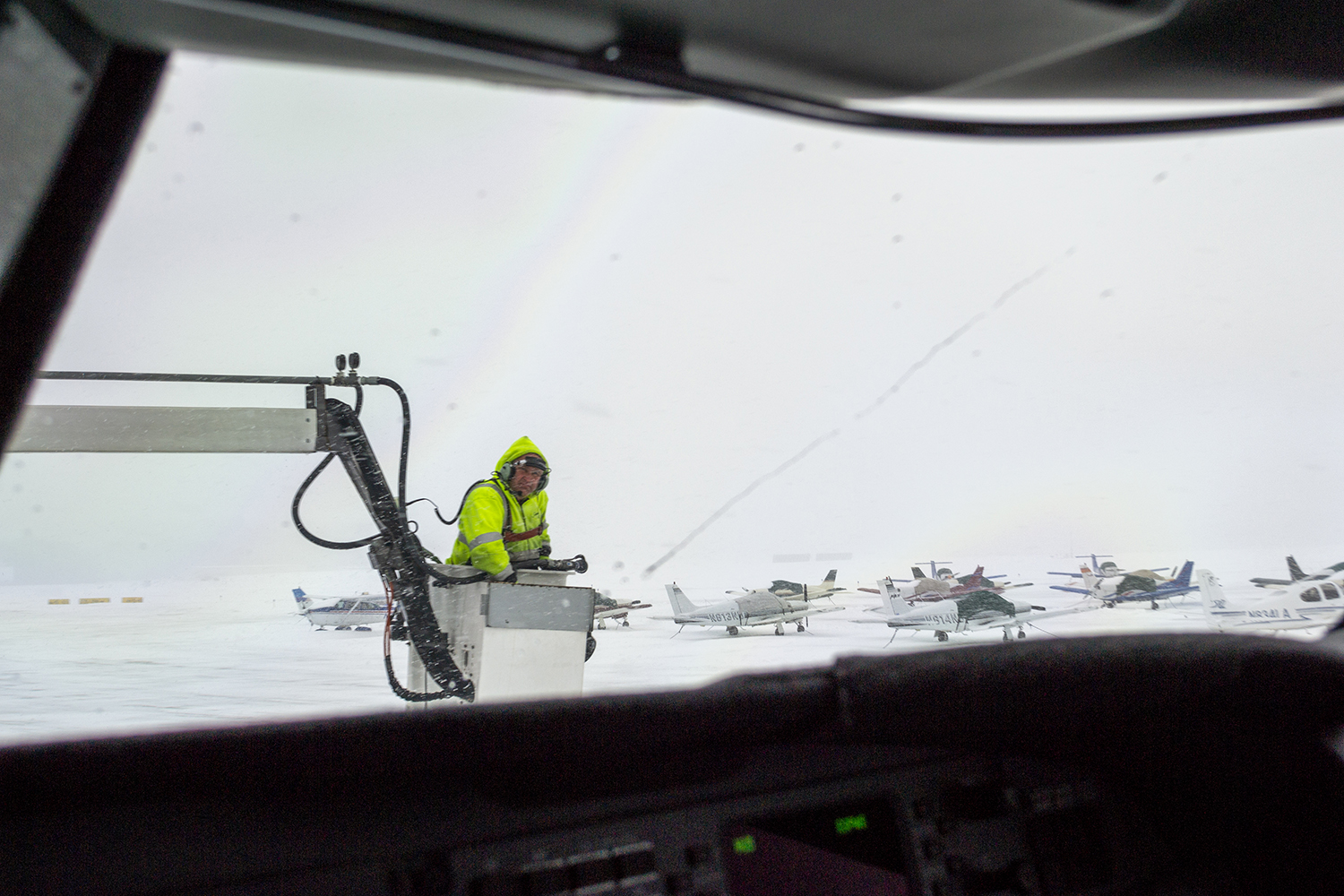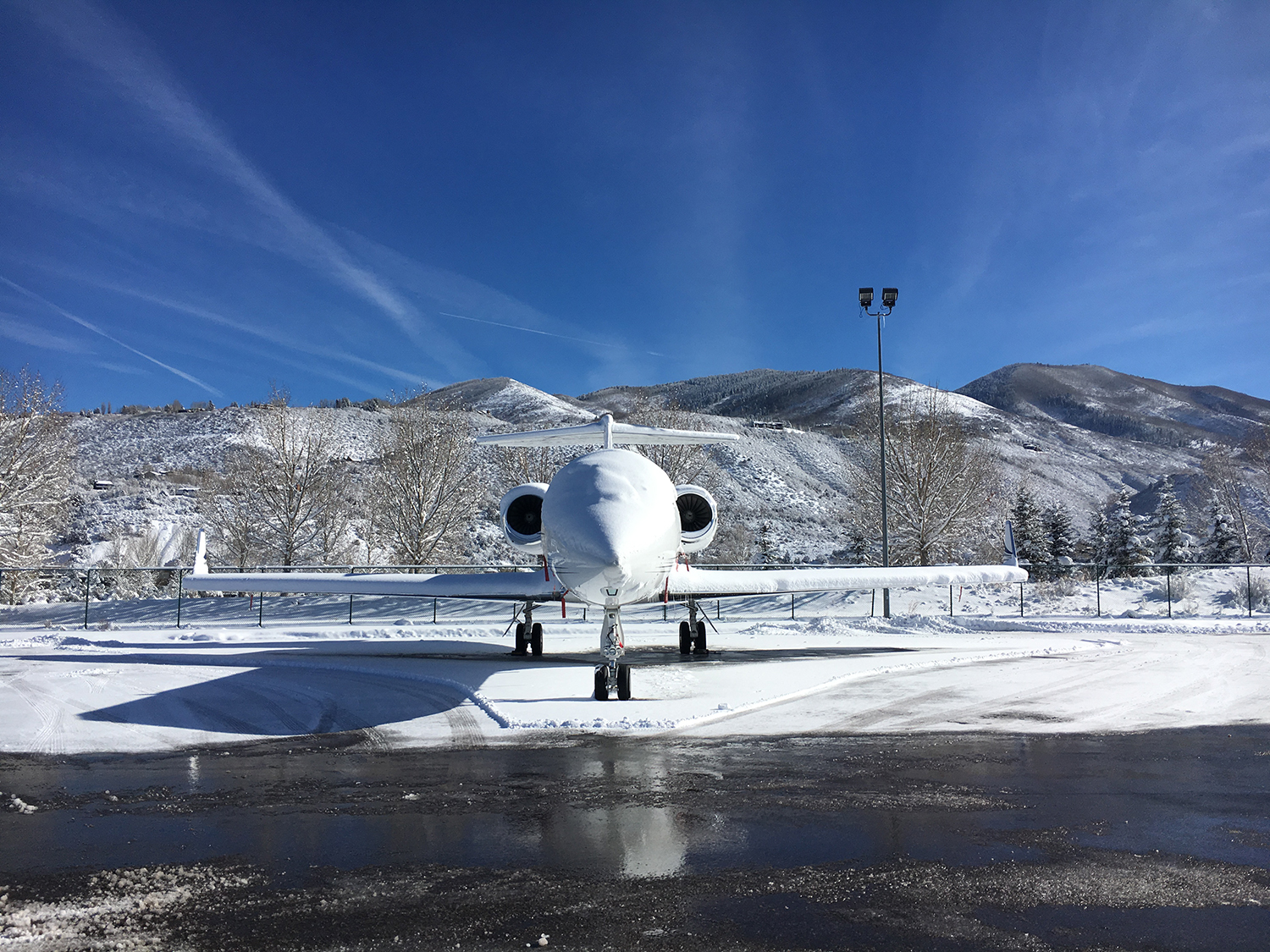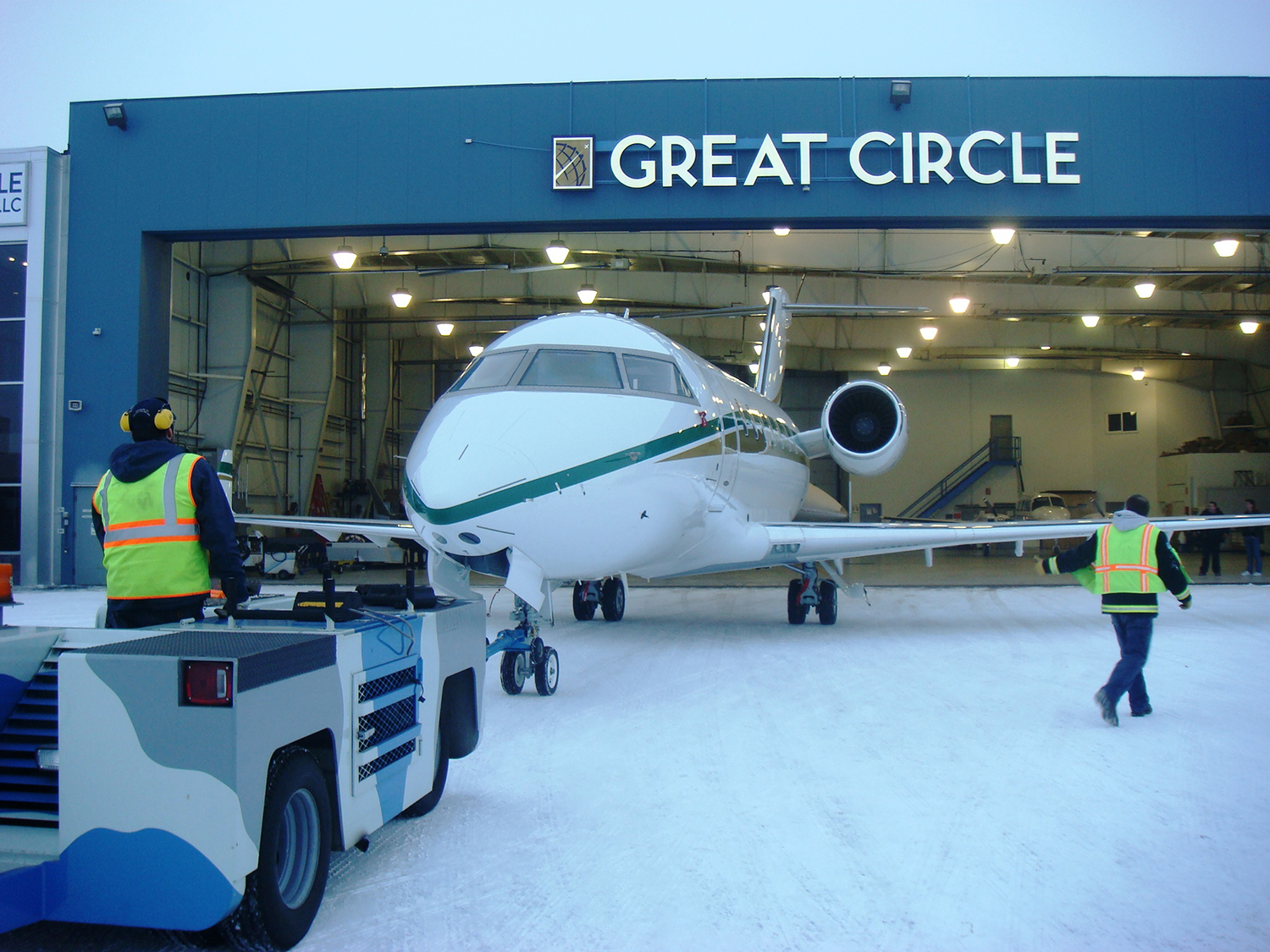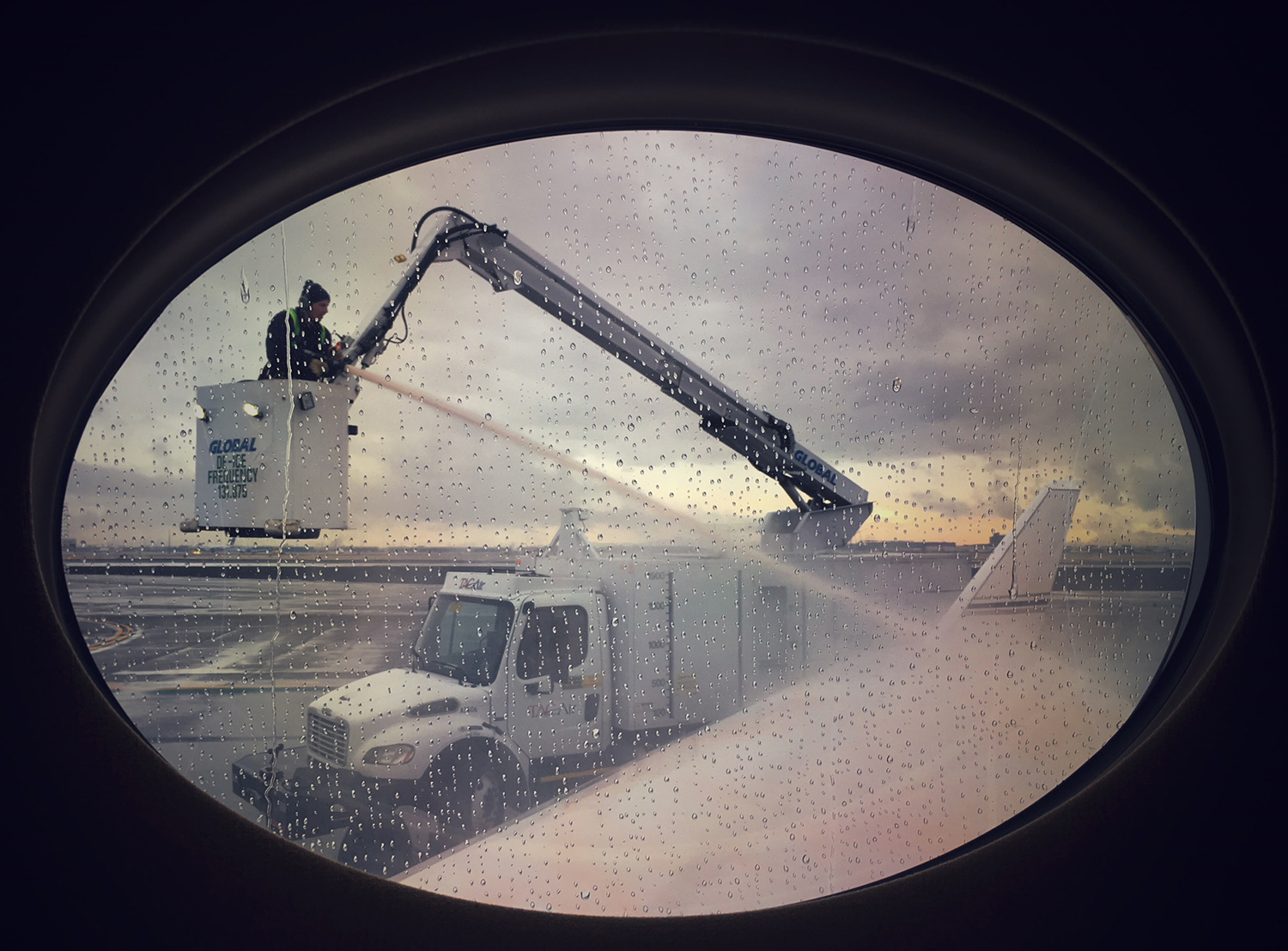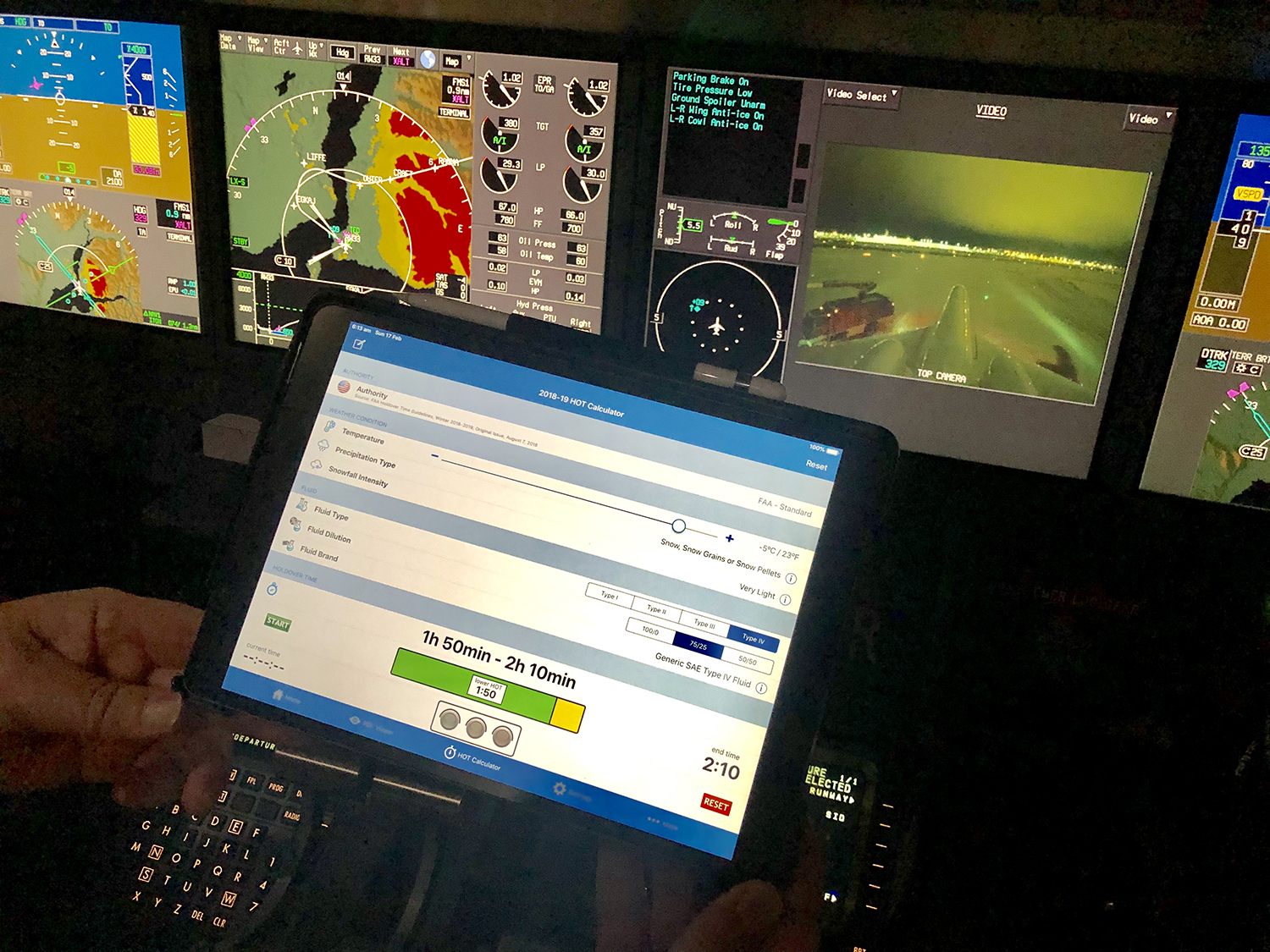Many of us in the Northeastern United States have become so well practiced at the art of departing on a day with snow and ice, we can border on complacency. This can be especially problematic for anyone changing aircraft types, since some aircraft have unique procedures that are critically important. So, we cannot hope to produce a “one-size-fits-all” checklist for your next departure in snow. But what follows can serve as a quality control check for the checklist you already have, or the foundation of the checklist you’ve needed all along.
— James Albright

Updated:
2022-12-01
Me? I’ve been dealing with snow and jets for over forty years. But a few years ago I moved from one type to another and the procedures in the new jet are different than the old. I need that checklist as much as the “noobe” just getting used to trudging around an airplane dripping with glycol.
1 — Check the forecast, adjust departure time if possible and advantageous
2 — Consider reserving hangar space or even repositioning the aircraft
5 — Consider prepping the airplane for de-ice/anti-ice using mechanical methods
7 — Taxi more slowly than you think necessary
8 — Customize and follow a de-icing / anti-icing procedure
9 — Consider Hold Over Time (HOT) Tables and what they mean for you
10 — Brief your passengers ahead of time
11 — Know what needs to be done following de-icing / anti-icing
12 — Brief the unusual before takeoff

1
Check the forecast, adjust departure time if possible and advantageous
If going an hour earlier or later means not having to get in line for de-icing/anti-icing, the reduced sitting time in the airplane may be appealing to passengers. No doubt the reduced operating cost will appeal to the bill payers. The departure time adjustment could be just an hour, but that might be more than enough.
Short story:
A few years ago, I was waiting for passengers in Teterboro while it was snowing, but things hadn’t yet reached the stage where the airport was using what they call “gate hold” procedures. Our passengers said they were delayed but would be on the road from Manhattan shortly. By the time they showed up, gate hold procedures were up to two hours and it appeared the airport was losing the battle with Mother Nature. Thirty minutes after our passengers showed up, the airport closed. Everyone headed for hotels. The next morning it took us three hours to dig the airplane out. The de-ice bill was epic. Thinking back, had I been more situationally aware of the intensifying snowstorm, I might have been able to convince our passengers to return more quickly and we could have avoided the mess entirely.
2
Consider reserving hangar space or even repositioning the aircraft
Paying for a night in a hangar can be much cheaper than to have the airplane deiced the next day. If no hangar space is available, it may even be cheaper to fly someplace nearby with hangar space.
Short story:
I once flew for an owner who would not pay for hangar space away from our home airport. We never considered asking because we knew the answer ahead of time. We once departed Pittsburgh having spent over $6,000 to deice the airplane following an overnight snowstorm. We could have kept the airplane in a warm hangar overnight for less than $500.
3
Call the airport to make sure they have the right kind of de-ice/anti-ice fluid on hand, the truck is operational, and they have the staff to operate it
You should keep in mind that the person who picks up the phone at the airport Fixed Base Operator (FBO) may not be thinking about de-ice/anti-ice or may have never been trained. “Do you guys de-ice?” can get you the right answer, but it may also set you up for failure. “Do you have Type I and Type IV de-ice and anti-ice fluid? What is the manufacturer’s nomenclature for each fluid? Are your trucks operational and do you have qualified operators on hand for our departure time?” These questions may seem insulting, but a knowledgeable FBO operator will recognize they are dealing with someone who knows the right questions to ask.
Short story:
In one of my flight departments we had a pilot ask “do you have Type IV” only to show up on departure day to find out the Type IV was sitting in a truck that broke months prior and was awaiting parts. They were stuck until the sun came out and turned the layer of frost into water, a delay of over six hours.
Some airports have a proactive staff, often called "Airport Operations," that will work with operators to make sure the ramp and runways are kept open when they can expect activity. At my home airport, Hanscom Field, Bedford, Massachusetts (KBED), Operations calls their primary operators the day before any expected "snow event," and will customize their snow plan to improve the odds everyone gets out when they want to. They are manned 24 hours a day and are only too glad to give a situation report.
Another short story:
We were inbound from France, expected to arrive at midnight, an hour after the tower closed and certainly after most of the airport staff had gone home. The North Atlantic winds were unkind and our ETA slipped almost an hour. The weather report had actually improved after a system dumped epic amounts of wet snow. I called airport operations and the night supervisor was happy to talk. "We know you are inbound but if you can fine tune your arrival time and let us know where on the field you are going, we'll make sure we have a path plowed out for you." We arrived to a plowed runway and a path to our hangar.
4
Adjust “show time” forward: everything happens more slowly when the airport is covered in snow or ice.
Video: Judging the rate of snow fall.
You should start each snow departure day with a “big picture” assessment of what you are facing. Knowing what you are dealing with can alert you to the need to let your passengers know they can sleep in a few more hours, or that you can save your schedule with an early show. Getting to the airport an hour or two early can pay dividends and avoid a delayed departure of many, many hours. There will be a waiting line for brooms, squeegees, fuel trucks, water trucks, lavatory service carts, de-ice/anti-ice. Your exterior preflight inspection will have to be more thorough even as it will become more difficult because of the cold.
There will be a justifiable tendency to slow everything down to avoid accidents. All levels of air traffic control can add to the slowdowns as the system becomes saturated with airplanes trying to flee the cold.
Short story:
We showed up one morning at Teterboro, two hours prior to our 0700 takeoff time because we knew it would take some time to get the snow cleaned off the airplane. We arrived the night before with our sister aircraft, another Challenger 604. Their departure was an hour after ours, but they also planned to show up two hours prior to their 0800 takeoff time. Both crews were methodical and used identical procedures. We took off on time, they took off two hours late. They said they could have made it on time if it wasn’t for the fact they had to wait for line service to help brush off nearly two feet of snow from their wings, and then wait for fuel trucks that were busy with all the other 0800 departures, and then having to get in line for de-ice/anti-ice. In retrospect, showing up before the rush would have saved the day.
5
Consider prepping the airplane for de-ice/anti-ice using mechanical methods
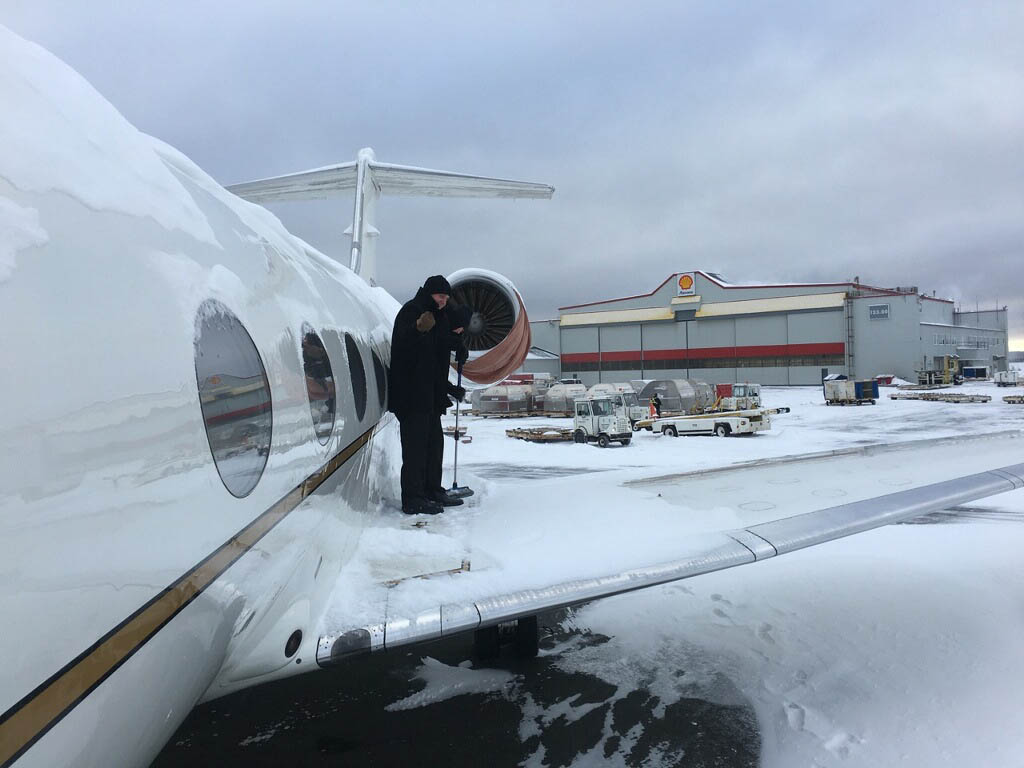
Sweeping the snow off a Gulfstream III's wings in St. John's International Airport, Canada (CYYT), courtesy Jeff Queen.
If FBO line technicians are busy with other airplanes, they might be willing to lend you long-handled brooms, squeegees, and ladders. Pushing the snow off your wings and other surfaces can make the de-ice/anti-ice process quicker and cheaper. Make sure to consult aircraft manuals for any prohibitions or specific guidance on what to do, and just as importantly, what not to do.
Short story:
The day after Teterboro closed, stranding us and our passengers, we returned to an airplane with two feet of snow on the wings and an equal amount of snow in front of each landing gear. The plows were busy as was every line technician on the airport. The delay threatened to extend into the next day. We scrounged around for two shovels and spent an hour digging a lane in front of each landing gear truck. Once that was done we traded the shovels for brooms and did our best with the wings. Because we had an airplane that was mostly ready to go, the FBO put us in the front of the line, towed us clear of our mountain of snow, and submitted our tail number to the airport, “ready for de-ice.” We got out that day, which is more than many of our snow-bound neighbors could say.
6
Brief everything
Even if you go through the de-ice/anti-ice and cold weather start procedures several times each week, when a new winter shows up you probably need a refresher. If you are moving from one aircraft type to another, or one airport to another, your existing memorized procedures may not be as complete as you may hope. You should know where all the existing aircraft, airport, and company procedures are, and you should have them handy so you can review them before each snowy day departure. Having a tailored checklist can be a life saver.
Short story:
My first takeoff following de-icing in a Gulfstream GV was following a twelve-year break from Gulfstreams and I wasn’t, shall we say, as well versed on the procedures as I should have been. I had assumed the obedient copilot’s stereotype of assuming the captain knew what he was doing and I would learn what I needed to know in due time. We took off from Nashua Airport, Nashua, New Hampshire (KASH) after taxiing through a messy ramp, but the airplane was coming from our toasty warm hangar, it was clean and there was no reason to de-ice. Right after takeoff the captain called “gear up” and as I dutifully retracted the gear a voice in my head said, “mistake.” A few hours later we landed. The captain gently set down the main gear onto a dry runway and as soon as that happened, the nose pivoted around the mains, slamming down hard. The brakes appeared to be locked, but of course they were caked in ice. Fortunately, they broke free, costing nothing more than some wear on the airplane and the captain’s reputation with our passengers. He said, “I should have left the gear down for a minute after takeoff to blow off the ice. I thought about it but forgot in the heat of battle.” Of course, I should have remembered too. Perhaps had we covered it in the briefing, one of us would have remembered.
7
Taxi more slowly than you think necessary
An old truism for driving on snow and ice holds true for aircraft: there is no prize for coming in first, only big penalties for those who don’t complete the race. (And it isn’t a race!) Taxi slowly on the straight runs and even slower when turns are involved. If you taxi on a contaminated surface faster than you can walk, you are probably going too fast.
Video: When the ramp is contaminated, taxi more slowly than you think necessary.
Short story:
When I first moved to Hanscom Field, Bedford, Massachusetts [KBED], I joined one of many of “small iron” operators that moved up to the Challenger 604. The wise operators imported at least a pilot or two already well versed in the larger iron, a few did not. As the story goes, one of the aircraft ended up clipping a wingtip into a hangar because, “the (insert your own adjective here) thing wouldn’t stop.” The pilots were used to the “power on, power off” capability of their turbo prop aircraft but unused to the idle thrust of the Challenger’s jet engines, especially at cold temperatures. When it comes to just about everything on a contaminated ramp, too slow is better than too fast.
8
Customize and follow a de-icing / anti-icing procedure
Chances are the team operating the de-ice truck have more experience at this than you, but you can’t bet on that. You should know your AFM procedures for applying de-icing and anti-icing fluid and be able to brief the de-ice team, on the radio if necessary, in short, succinct instructions. For my aircraft, I will have already removed all contamination from my cockpit windows, probes, and landing gear, and will have left the flaps retracted. Having taken those precautions, my brief is short and sweet: “Get the wings and tails and (if necessary) the top of the fuselage. Avoid any direct spray into any intake, probes, or the aircraft undercarriage.” If you can provide a complete briefing on the phone, you will be able to keep it even shorter and sweeter when on the radio.
Video: Following a specific procedure prior to de-icing.
Depending on your aircraft, there may be a specific sequence of events that has to happen prior to the application of any de-ice/anti-ice fluid, as well as another procedure to get the aircraft ready for takeoff with any fluid on the aircraft. Forgetting to turn certain systems off and close certain doors prior to fluid application can introduce harmful fumes into the cabin, or worse. Forgetting to undo what you’ve done can leave your aircraft ill-suited for flight.
Short story:
In one of my flight departments one of our pilots briefed the de-ice team, “get everything.” The other pilot was alarmed because he had never heard that answer before, but he couldn’t remember why that was the wrong answer. One of the properties of Type IV anti-ice fluid is that it is designed to shear from the airplane around 115 knots, and that’s what happened to the fluid on the nose of the aircraft as they raced down the runway, completely obscuring both pilots’ views just at V1 decision speed. They rotated and by the time the wheels were off the ground they regained visibility. Oddly, the pilot in command was known for saying, “I’d rather be lucky than good.” He got his wish.
9
Consider Hold Over Time (HOT) Tables and what they mean for you
A little-known secret in the general aviation community is that Hold Over Time (HOT) tables do not authorize Part 91 crews to skip a pre-takeoff contamination check within HOT times. (14 CFR 91.527 does not make any allowances for HOT tables.) In fact, only Part 135 crews with specific training (under 14 CFR 135.227) and ground crews with specific approval (under 14 CFR 121.629) may do so. Otherwise, Part 135 crews must complete a pre-takeoff contamination check within 5 minutes prior to takeoff any time conditions are such that frost, ice, or snow may reasonably be expected to adhere to the airplane. Part 91 crews would be well advised to follow suit. I recommend using the HOT Tables as advisory information, but if the conditions are conducive to further icing, you need to do a tactile inspection of your wings. You might be able to do this from your cabin windows, but in an aircraft with a fifty-foot wing span, or larger, I don’t think your eyes (or certainly my eyes) are good enough to do that.
I recognize that most flight departments choose to use HOT tables even if they aren't technically permitted to do so. Many Gulfstream GVII operators use the following warning to justify the use of HOT tables:
WARNING
WHENEVER THE RECOMMENDED HOLDOVER TIME IS EXCEEDED, A PRE-TAKEOFF FINAL INSPECTION IS REQUIRED. IF IN DOUBT, REPEAT THE DE-ICING PROCEDURE PRIOR TO TAKEOFF. REFER TO 03-20-10: Holdover Times for SAE Type I, II, III, and IV Fluid Mixtures.
Source: Gulfstream GVII AOM, §03-20-70
These pilots reason that if the recommended holder time is not exceeded, a pre-takeoff final inspection is not required. I'm not so sure. In my view, if the conditions are conducive to icing and you are not trained and certified under 14 CFR 135.227 and the ground crews under 14 CFR 121.629, then the HOT tables are purely advisory to you.
Video: Making a record of the de-icing.
Short story:
For some reason, many business aviation pilots think taking the time for doing a tactile inspection following de-icing will anger their passengers because of the time needed. In my experience, the opposite is true. Many years ago I was in the middle aircraft of a line of three Challenger 604s, three abreast, getting de-iced. We completed our de-icing while the first aircraft was waiting permission to takeoff. I opened our main entrance door and walked to the left wing tip, touched portions of the wing while inspecting the top and bottom, as well as the tail of the aircraft. I repeated the process on the right wing. The next day the pilot in the first aircraft called me to say I got him in trouble. His passenger wanted to know why that next pilot was more careful than he was. So word to the wise, do your tactile inspection because the pilot in the next airplane might be me!
10
Brief your passengers ahead of time
If your passengers are new to winter flying, having a nearby window coated in an orange or green goo can be alarming. Even seasoned passengers may be put off by the sudden delay. Letting them know ahead of time will not only avoid these problems but can serve to increase their confidence when flying in a less than CAVU (Ceiling and Visibility Unlimited) day. Keep in mind your passengers will have a good view of the process that should serve to inspire, not to alarm. You should have confident answers to: “What is that fluid?” “Why is it that color?” “How does it work?”
Video: A passenger’s view.
Short story:
After a few years in a new flight department, my passengers became used to the routine and started showing up a little early on those days it looked like we would need to de-ice. They even became used to the post treatment tactile check. We once had a few customers on board who were not used to the routine. I overheard our passengers give an accurate description of the process and the reason the tactile check was needed. Our customers were impressed. “You guys do everything right,” they said. I think that was meant as much as a compliment for the company officers as it was the flight crew.
Video: Watching the pilot ensure the wing is airworthy.
I preposition a towel (to wipe my hands after doing the tactile check), put on ear protection, ensure I don't have any loose items on me (lest they be sucked into the engines), and close the cabin door between the passengers and the cockpit before I open the aircraft's main entrance door. You might also consider a separate jacket and shoes for the chore. After I've done the tactile check, I re-board the aircraft, close the main entrance door, and open the door to the cabin. Then I clean off my hands, take off my jacket and hearing protection, and give the passengers a wink. Am I putting on a show for their benefit? I suppose I am. But part of my job is instilling confidence in those that are putting their lives in my hands.
11
Know what needs to be done following de-icing / anti-icing
Most aircraft have a few steps needed before de-icing that will make takeoff and climb out difficult or impossible if not reversed after de-icing. You may need to seal off the fuselage by closing outflow valves and engine bleed valves. You might need to turn off Pressurization and Air Conditioning Kits (PACKs). You might need to retract the flaps or not extended them in the first place. Whatever it is you did or didn’t do, you will probably need to undo what you did, and do what you didn’t do. Delaying the normal taxi checklist might work, or you might need a new checklist for this specific situation. Don't forget that on landing, even on a dry runway, you may have things to do because of the mess you taxied through on takeoff. In the GVII, for example, the parking brake must be cycled three times prior to landing.
Video: Getting the aircraft from de-ice mode to flight mode.
Short story:
When I was based at Houston Intercontinental Airport, Houston, Texas (KIAH), we were not well versed at the art of cold weather operations. Having the aircraft de-iced caused most of us to dive into the Airplane Flight Manual and to call ahead to the airport’s operations office to learn how it was done by those who did this regularly. But two of our pilots neglected both steps. When it came time to de-ice, they got into several arguments: Should the APU be running? Should the engines be operating? Should the air conditioning system be turned off? (My answers: No, Yes, Yes. Their agreed upon answers: Yes, No, Yes.) They took off with the pressurization system off, became confused when the master caution light and “Cabin Alt” message illuminated at 10,000 feet. In another minute or so the passenger oxygen masks dropped just as they figured out the PACKs had been left off, thereby inducting both into our local pilot hall of shame.
12
Brief the unusual before takeoff
It has become fashionable to brief only the threats to takeoff. If dealing with an airplane dripping with anti-icing fluid or about to takeoff in the snow isn’t a threat, what is? Some pilots like to complete all briefings, including the takeoff briefing, prior to engine start. No matter your practice, it would be a good idea to cover the unusual things about taking off into the snow or following de-icing, just before takeoff.
Video: The last minutes before takeoff.
Short story:
I’ve been using pretty much the same de-icing/anti-icing and contaminated runway takeoff procedures for a few decades now. That kind of history breeds complacency. Even worse, however, is that when procedures change we (and by that I mean me) have a tendency to revert to how we’ve always done it. Every aircraft I’ve flown prior to my current aircraft, the Gulfstream GVII, had a limitation telling us not to turn on wing anti-ice prior to applying takeoff thrust if the wings are coated in Type IV anti-icing fluid. The GVII, is just the opposite. Not only are we required to turn on wing anti-ice, we have to have it on for at least four minutes, we have to verify the wings have come up to temperature, and we have a twenty-minute limit for total time with the wing anti-ice on before the wings have to be cleaned off. The procedure is so radically different that we make a big deal of it. I just hope we continue to do that until it becomes ingrained into our subconscious like the old procedure was.
13
Remember what is different about the takeoff procedure
We often strive to make every takeoff the same, just as we try to do the same for every landing. This type of consistency helps us to keep things safe under most circumstances. But things may be different on a snow-covered runway or glycol covered airplane. Hold the brakes until power is set or gradually add thrust and let the airplane roll? Full, rated thrust only to improve balanced field numbers, or reduced thrust to improve directional control. Speaking of directional control: rudder only, or tiller only until the rudder is effective? Retract the gear normally or leave it down for a while longer? On the numbers, or add some just in case? You need to know what your manufacturer recommends, or if those recommendations have changed.
Video: Takeoff procedures may need to be adjusted on a contaminated runway.
Short story:
When I flew the Gulfstream III as an Air Force pilot with the 89th Airlift Wing at Andrews Air Force Base, Maryland (KADW), the C-20B was brand new. The Air Force had just published a flight manual with the catchy name, Technical Order 1C-20B-1. We also used the Gulfstream Airplane Flight Manual, the FlightSafety flight manual, and yet another from SimuFlite. Now and then we discovered we had four different procedures for doing the same thing. If you find yourself in a similar situation, you should probably default to the manufacturer’s position. At the very least, you need to investigate and decide before you find yourself at the end of a runway, ready to push your throttles to takeoff thrust.
14
The “checklist checklist”
If I’ve left you with the distinct feeling that there is no one-size-fits-all checklist for departures in snow, then my job is done. Some manufacturers leave you no choice but to come up with a “checklist checklist.” That is one that has you pull out other checklists and bounce from one to another. This used to be an industry accepted practice, leaving hapless copilots with several checklists bookmarked with fingers as the referred to lists grew and decreased as they were completed. How do you do that with an iPad? It may be in your best interest to write your own checklist. However you do it, you need to consider what goes in that checklist before the first snowflake falls in anger. (To coin a phrase from my military past.)
References
(Source material)
GVII-G500 Issue 1 Operating Manual, Revision 8, October 28, 2021
Please note: Gulfstream Aerospace Corporation has no affiliation or connection whatsoever with this website, and Gulfstream does not review, endorse, or approve any of the content included on the site. As a result, Gulfstream is not responsible or liable for your use of any materials or information obtained from this site.
